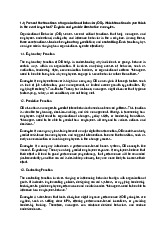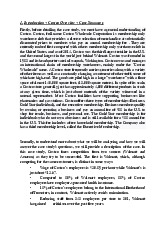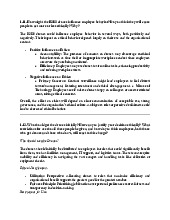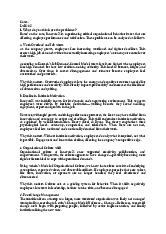







Preview text:
NATIONAL ECONOMICS UNIVERSITY
SCHOOL OF ADVANCED EDUCATIONAL PROGRAMS *** ------- -------
ORGANIZATIONAL BEHAVIOR REFLECTION ESSAY
Student name: Nguyễn Ngọc Vân Anh Student ID: 11220404
Class: Quản trị Marketing 64B CLC
Lecturer: Ph.D. Nguyen Duc Kien
Ha Noi, October 2024 lOMoAR cPSD| 58591236 A. INTRODUCTION
In the words of Socrates, 'Know thyself.' This timeless exhortation serves as a powerful
reminder of the importance of self-awareness in our journey of personal and professional
growth. The quest for self-knowledge can unveil profound insights, yet it often leads us through
a labyrinth of challenges - both within ourselves and in our interactions with others. As we
navigate life's complexities, we may encounter conflicting values and differing perspectives
that can significantly shape our experiences and overall quality of life.
In this self-reflection essay, I will delve into three interconnected areas that have
profoundly influenced my understanding of myself and my place in the world: intrapersonal
value conflict, nonverbal communication, and the quality of work life. Each of these themes
has its roots in the intricate web of our beliefs, relationships, and work environments, and they
all contribute to the tapestry of our identities.
In the first section, I will explore the internal struggle that arises when my core values
clash, prompting me to negotiate between competing ideals and expectations. Following this, I
will examine how nonverbal communication creates both challenges and opportunities for
growth in my relationships and career. Finally, I will reflect on the role that my work life plays
in this equation, considering how the environment in which I operate can either nurture or
hinder my quest for fulfillment.
By examining these themes, I aim to uncover the insights that have emerged from my
struggles and triumphs, ultimately leading to a deeper appreciation of the unique landscape of
my identity. In doing so, I hope to provide a clearer understanding of the dynamic interplay
between self-awareness, means of communication, and professional satisfaction, as well as the
vital role they play in shaping who we are. B. REFLECTION I. THE INDIVIDUAL
SELECTED TOPIC: INTRAPERSONAL VALUE CONFLICT 1. D - DESCRIBE
One thing I realize now is that: In my journey of self-reflection, I have often found
myself grappling with intrapersonal value conflict, particularly between my instrumental value
of ambition and my terminal value of happiness. This internal struggle has become painfully
clear during a pivotal moment when I find myself at a crossroads in my career pursuit - in my
third year of college. My current major in marketing, which I was once passionate about,
seemed to overshadow my true happiness: writing. For years, I have dreamt of a different life
- one filled with the aroma of coffee wafting through a small bookstore nestled in the suburbs,
where I could immerse myself in the world of stories, both as a content creator, a writer and a
reader. As I settled into my marketing study, I began to notice the toll it was taking on my
creative spirit. Each day spent crafting marketing strategies or evaluating data left little room
for the imagination that once fueled my desire to write. I often caught myself daydreaming
about that little bookstore, where I envisioned hosting book clubs, sharing my own written
works, and engaging with a vibrant community of like-minded individuals. Yet, each step I took lOMoAR cPSD| 58591236
towards climbing the study ladder seemed to pull me further away from that dream. I realized
that while ambition is often celebrated, it comes at a cost. As psychologist Barry Schwartz notes
in "The Paradox of Choice", the abundance of options and the pressure to succeed can lead to
increased dissatisfaction and anxiety, as individuals feel compelled to prioritize ambition over
authentic happiness (Schwartz, 2004). This conflict forced me to confront what truly matters to
me: the pursuit of a fulfilling life steeped in creativity and community, rather than conforming
to societal definitions of success. The decision is far from easy, as I grapple with the fear of
financial instability and the uncertainty that comes with a non-traditional career path. However,
this introspection has illuminated the path that aligns more closely with the essence of who I
am and what I genuinely desire from life. According to philosopher and author Alain de Botton
in "The Course of Love", true fulfillment often lies beyond conventional expectations, urging
individuals to define their own sense of purpose and happiness (de Botton, 2016). I am
reminded that true fulfillment may not necessarily lie within the confines of conventional
security but rather in the courage to carve out a niche that resonates with my soul. 2. I - INTERPRET
Through this valuation and intrapersonal conflict, it becomes evident that ambition must
also be synonymous with happiness because it is disheartening for the individual to be told that
success means going up the vertical ladder of a corporate organization. This cultural clash
makes me believe in the lives of many people that there comes a time when they have a burden
to chase professional goals while neglecting personal happiness. I place myself in this
phenomenon as there emerged a “happiness paradox” which was brought forth by researchers
such as Ed Diener, who assessed that external accomplishments do not bring internal
satisfaction (Diener & Seligman, 2004). Instead it asserts that owning up to and living out one’s
value while engaging in work activities brings true happiness – something I have failed to attain
in performing marketing tasks. It makes me then ask the fundamental question of what being
successful is. Often success is defined focusing on how many cars or houses one possesses, the
titles always bring applause and creativity and satisfaction gets blurred along the way. As long
ago wrote psychologist Mihaly Csikszentmihalyi, working on flow, genuine satisfaction comes
when people do what gives the feeling of being alive, such as writing or talking to people
(Csikszentmihalyi, 1990). The conclusion then prompts me to abandon the traditional measures
and forms of success and seek the new ones. 3. E - EVALUATE
In light of the understanding I have acquired in relation to the value conflict I have
personally experienced, my comprehension of the link that clearly exists between one’s
priorities and values, one’s vocation, and the overall state of life has significantly deepened.
This realization connects very well with some of the ideas I covered in my Organizational
Behavior classes in particular about EQ and values based leadership development. As Daniel
Goleman has once said, self-awareness and self-regulation are two of the key ingredients in
becoming the kind of a leader that has the ability to be satisfied with themselves. Having the
thought and processes of value conflict within me, I have become more aware of how I can
confidently state my interests in the things I do and the aspects of what I do in this context that
also do not have an influence as to why I do it. Knowing this enables me to control what I feel, lOMoAR cPSD| 58591236
how I feel it and the decisions that follow suit, which is all about emotional intelligence. It is
also worth mentioning that literature on values based leadership focuses primarily on the need
for followers to have congruence with their organizational values. Indeed, Kouzes and Posner
argue that authentic leaders create such environments where shared values are nurtured in order
to provide cohesion in teams. In as much as the course of my career may look to undermine the
core values that I hold dear, it is critical to note that this is part of the learning that will enable
me to seek for structures that will ensure greater creativity and maximized personal satisfaction. 4. P - PLAN
Despite the fact that I recognize the concept of intrapersonal value conflict, its
significance to my Organizational Behavior class as well as to my future career is more
profound. There is no doubt that in the future positions that I am going to perform, I will attempt
to put in practice the principles of Emotional Intelligence studied i.e. use self-awareness to deal
with complex relationships in the workplace. Drawing on Kouzes and Posner (2017), a
favorable environment for open conversation and real crossing of values is built by skillfully
managing one’s and other people’s values. In such a situation, in the profession where I will be
able to advocate the notion that I can realize myself without making sacrifices in my
professional development, I will have to look for more opportunities of being innovative and
creative. Not only will this increase my job satisfaction but other organizations will also
increase as I will try to base practices on resolving and acknowledging employee value
conflicts. In the end, the philosophy that I have adopted will work to help me achieve the
objectives that I have set for myself, which in turn will lead to realization of a career that is not
only unattainable, but which will bring satisfaction. II. THE GROUP
SELECTED TOPIC: NONVERBAL COMMUNICATION 1. D - DESCRIBE
Through my recent experiences in team collaborations, I have come to truly appreciate
the importance of nonverbal communication - something I had previously overlooked. During
a group project presentation, I noticed how my teammates’ body language, facial expressions,
and eye contact played a crucial role in shaping the audience’s perception of our message, often
more than the actual words we spoke. One teammate, who spoke with confidence but avoided
eye contact, seemed to lose the audience's interest, while another, who appeared less
knowledgeable, managed to engage everyone with genuine enthusiasm and open gestures. This
difference underscored Albert Mehrabian's (1971) research, which points out that a significant
portion of our communication is nonverbal, indicating that tone, body language, and facial
expressions can greatly enhance - or detract from - effective messaging. I realized that
nonverbal communication can either support or contradict what we say, influencing how our ideas are received. 2. I - INTERPRET
The concept of nonverbal communication enlightens, especially its elements of kinesics
(body language) and paralinguistic (the way in which messages are communicated) so we see lOMoAR cPSD| 58591236
that there is a lot that goes on in communication that we are not aware of. It is accepted that a
great deal of communication is in the non-speaking or nonverbal area and therefore one can
easily see that, for one reason or another, even the most discrete of us can and do often act
contrary to our speech. This is why such scholars as Burgoon et al. (2016) also argue that hand
gestures are techniques for emotion and intention states that are more satisfactory compared to
pure verbal communication. Picture such a paradox occasion in organization communication
and I am importuned to look into the drawbacks relating to miscommunication or lack of
understanding amon-go teams. For example, one look at the boss, who folds his arms, and the
members of the team may conclude that there is cause for fear, rather than the boss’ interest to
interact with the members (Guerrero et al., 2011). Another issue I am interested in are the
various cultures that see different meaning in non-verbal cues are used - the more specific the
better as it is quite different - praise as a phrase in English abstract meaning that in one culture
is understood as a threatening statement instead of a joking one(Moran & Stripp, 2021). This
seems very natural in view of the soft competence where I also talked about the importance of
non-verbal behavior impact on social relationship and effective leadership. I contemplate over
the core aspect discussed: How do we increase the level of understanding on nonverbal issues
while working in terms of diversity and having no excluded team members? 3. E - EVALUATE
Reflecting on the deeper comprehension of non-verbal communication I have acquired
has made me realize the decisively indispensable nature of this aspect of organizational
behavior activism. Therefore, the locus of non-verbal communication has shifted from a too
general perspective of its immediate ability to meaning that focuses on its demonstrability and
the psychomotor meaning that the non-verbal cues refer to what the other participants are doing
and saying micro-interactions. According to social exchange theory, Interdependency between
working adults is resultant from the perception of rewards in the relationship and the
participants each activity offers (Nash, 2017). This in turn motivates other teammates to
reciprocate or return the favor by behaving supportively which is a desirable position for
promoting cooperation and information exchange.
In addition, earlier views held that verbal language was the driver of all effective
communication altered. It has been revealed through studies that usually non-verbal cues such
as facial expressions and gestures dominate in emotional and intention interpretation (Burgoon
et al., 2016), presenting to me the challenge of how to apply it in my profession in the future. I
have now become sensitized about having congruent verbal and non-verbal communication, as
it applies significantly within my scope of communication. For example, the research
conducted by Knapp and Hall (2010) explores one other gelling point due to the fact that
echoing reassures the audience and reassurance is invaluable to the line. It is to say, I have
realized that investing time on working out my non verbal communication is more beneficial
considering that the art entails managing both verbal and non verbal aspects hence increasing
my potential to access and control people. It’s a self actualization in a neural linguistics program
whereas I can talk into working with other people more effectively by operating changes within organic social systems. lOMoAR cPSD| 58591236 4. P - PLAN
I reckon that the skills I have acquired in the field of understanding nonverbal
communication will play a crucial role in that Organizational Behavior course and once I
proceed to the workforce in general. The body language and even the speaking pitch are
examples of tools that I will use in a strategic way in the execution of effective leadership,
working together with others, among other necessary characteristics of success. Constructing
effective teamwork and promoting power and trust among the folks will include employment
of nonverbal techniques especially towards coworkers and the customers. Exploring the
differences that exist between universal ways of nonverbal communication within different
cultures allows me to not only become an effective leader of individuals of various backgrounds
but also create a room for all participants to contribute their voices and to be valued (Moran &
Stripp, 2021). As I plan to venture in such positions in the future, I intend to work more on
improving my EQ since I am confident that interpersonal skills in nonverbal cues are not only
for matters of communications but also vital in conflict management. This problem in the study
was that it does not consider the role nonverbal communication plays in leadership but shows
that such effective leadership can be imparted (Goleman, 2006). This theory of communication
development endorsed in this article will facilitate my interaction with others to a greater extent,
and I will be able to engage in fruitful professional communications with no restrictions. Hence
as I approach my profession, I anticipate using all the knowledge on nonverbal communication
in conveying appropriate messages and consequently building a valuable organizational
communication that harnesses clear and effective communication. III. THE ORGANIZATION
SELECTED TOPIC: QUALITY OF WORK LIFE 1. D - DESCRIBE
Initially, I regarded work in a rather superficial manner. I was obsessed with getting
things done, never appreciating the complexities of the quality of work life, as there was no
difficulty seen in measuring it through output or performance metrics. It is only after having
been exposed to the lessons and interactive discussions from Organizational Behaviors that I
understand that quality of work life comprises other realms other than the job. Through a group
project case study, it has become apparent that developing a positive work environment is not
about being good to employees only, it also influences the overall company performance. After
going through these ideas I had to expand my view on every related issue. Ever since, all these
controlled factors have made me appreciate the need for quality of work life and I have been
motivated to work for such objectives in the future organizations. 2. I - INTERPRET
Emerging from the perspective of “The quality of work life” illuminated me on how I
can, or should, sustainably enjoy being committed to an organization. This is the ratio of the
need for work and personal gratification and it reinforces the point that it is not just the pay that
employees are interested in and would like, but also a warm surrounding, work worth doing or lOMoAR cPSD| 58591236
worth doing one’s best, and chances for development. It is also consistent with Maslow’s needs
hierarchy which would explain any job satisfaction, that is, the satisfaction to be obtained after
the motivation in fulfilling certain psychological and self-fulfillment needs (Maslow, 1943). It
can also be related to Herzberg’s Dual Factor Theory which advances that the motivation of
employees in jobs is not based on salary only but also on recognition and achievement
(Herzberg, 1966). But implementation of the quality of work life programs is fraught with
challenges e.g. resource mobilization and dealing with unique needs of every individual. There
is a particular challenge in that here, where I wonder how effective quality of work life
programs are in reality and what aspects of them may be most important across different
organizational settings. Responding to these challenges is necessary as the application of the
quality of work life will bring a significant transformation in the workplace and the attitudes of
employees. As I move ahead with my career, my focus shall be on the quality of work life, in
the hope of improving the working conditions of both myself and others and as a consequence
there will be positive changes made within the organization. 3. E - EVALUATE
My personal reflection unveils that if the quality of work life has been given more
emphasis, then issues of job satisfaction, employee commitment and performance are defined
within it. These arguments are consistent with the proposition of Social Exchange Theory,
which argues that positive experiences of employees in a given organization will lead to an
increased level of commitments and investments in the same organization (Blau, 1964).
Furthermore, in relation to areas such as transformational leadership, it does also impact the
quality of work life positively as it seeks to provide motivating and inclusive environments.
Leaders who celebrate members within the team and are helpful have the ability to make their
team members feel an integral part of the team and have objectives effectively pursued in
coordination with those of the organization (Bass & Avolio, 1994). This last element has altered
my concept of leadership such that I believe that preventing practices which are harmful to a
positive work environment is more about encouragement and involvement of youth workers as
opposed to suppression of their vices. 4. P - PLAN
Analyzing what all has been studied about the said topic “The quality of work life”, I
appreciably grasp how relevant it is in relation to my Organizational Behavior module and the
future that lies ahead of me. These ideas which I have gained from this course will be a
specifically guiding principle in my career because I am aiming to work in management. The
quality of work life will be a very key issue as a matter of fact in running any business in a
productive manner. And so I will have to work hard to protect my interests in helping to achieve
their goals by advocating in favor of the well-being and involvement of company staff which
will facilitate respect and high performance in such an organization. Indeed, such acquired
learning will lay down a pattern in my professional development and will enable me to be more
effective in the workplace carrying out the planned activities better and motivating myself to
raise the level of the quality of work life for employees. lOMoAR cPSD| 58591236 C. CONCLUSION
In conclusion, this reflection essay has highlighted the interdependence of individual,
group, and organizational dynamics within the framework of Organizational Behavior. At the
individual level, addressing intrapersonal value conflict has enhanced my self-awareness,
emphasizing the importance of aligning personal values with professional goals for authentic
decision-making. On the group level, I have learned that nonverbal communication plays a vital
role in fostering effective collaboration. By being mindful of nonverbal cues, I can create a
more cohesive team environment, where trust and understanding thrive. Finally, my exploration
of the quality of work life has underscored the significance of a supportive organizational
culture that prioritizes employee well-being. This lesson reiterates that organizations investing
in their employees’ quality of work life benefit from increased morale and productivity.
Together, these insights equip me to navigate the complexities of human interactions in
the workplace. I am committed to fostering self-awareness, effective communication, and a
positive organizational culture as I embark on my future career journey. D. REFERENCES
Bass, B. M., & Avolio, B. J. (1994). Improving Organizational Effectiveness Through
Transformational Leadership. Sage Publications.
Blau, P. M. (1964). Exchange and Power in Social Life. Wiley.
Burgoon, J. K., Guerrero, L. K., & Floyd, K. (2016). Nonverbal Communication. Routledge.
Brown, B. (2018). Dare to Lead: Brave Work. Tough Conversations. Whole Hearts. Random House.
Csikszentmihalyi, M. (1990). Flow: The Psychology of Optimal Experience. Harper & Row.
de Botton, A. (2016). The Course of Love. Penguin Books.
Diener, E., & Seligman, M. E. P. (2004). Beyond money: Toward an economy of well-being.
Psychological Science in the Public Interest, 5(1), 1-31.
Goleman, D. (2005). Emotional Intelligence: Why It Can Matter More Than IQ. Bantam Books.
Guerrero, L. K., Anderson, P. K., & Afifi, W. A. (2011). Close Encounters: Communication in Relationships. Pearson.
Herzberg, F. (1966). Work and the Nature of Man. World Publishing.
Kouzes, J. M., & Posner, B. Z. (2017). The Leadership Challenge: How to Make Extraordinary
Things Happen in Organizations. Wiley.
Mehrabian, A. (1971). Silent Messages: Implicit Communication of Emotions and Attitudes. Wadsworth Publishing.
Moran, R. T., & Stripp, R. F. (2021). Managing Cultural Differences: Global Leadership Strategies
for Cross-Cultural Business Success. Routledge.
Moran, R. T., & Stripp, R. F. (2021). Managing Cultural Differences: Global Leadership Strategies
for Cross-Cultural Business Success. Routledge.
Maslow, A. H. (1943). A Theory of Human Motivation. Psychological Review, 50(4), 370-396.
Schwartz, B. (2004). The Paradox of Choice: Why More Is Less. HarperCollins.




